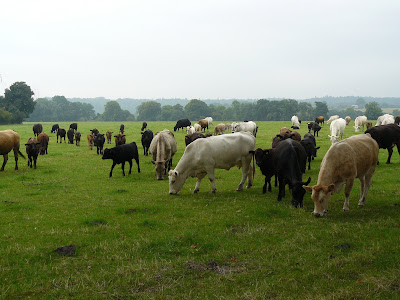 A bridge on the Kennet and Avon
A bridge on the Kennet and Avon
This is the fourth leg of the BBC's splendid
Berkshire Way, from Hamstead Marshall to Newbury (4.75 miles). The walk begins in Hamstead Marshall and heads north, climbing across some delightful open fields. After crossing a lane, you enter the vast, privately owned, Hamstead Park. Quite quickly you come on the extraordinary sight shown in the photo below.

The background is easy enough: the church of St Mary. But what of the two sets of gate posts? In fact, as you look around, no less than eight sets can be identified.
They are, it turns out, the remnants of a mansion built for the first Earl of Craven. Most date from the building of the great house between 1663 and 1697, though some may be later. The walls and gardens which they gave entry to have long since disappeared for the house burnt down in1718.
We were also struck by the contrast between the yellow hay wheels which littered the field and the deep green of the grass.
Shortly after this we took a wrong turn (excuse: the path had been diverted from its correct course) and wondered more deeply into the park and towards the newer great house. A classic country house park with some lovely trees. We saw a grey heron take off from the stream at the bottom of the slope.
 Hamstead Park
Hamstead Park
Leaving the park, you cross the river Kennet with this delightful view of the (private) Craven fishery. The Craven family were lords of the manor from the time of the first Earl into the mid twentieth century and their name lingers on in many places in the village.
 Craven Fishery
Craven Fishery
From there on, the route follows the Kennet and Avon canal for three miles or so into the centre of Newbury. The canal is very pretty at this time of year with lots of wild flowers and even some yellow water lilies just coming into flower.
The official directions are very vague about the last part of the route, simply saying that you should look out for Victoria Park on the left. In fact after the instructions run out, you cross the delightful Newbury Lock island, approach the bridge below, climb up and across the road and continue on the tow path until you do indeed find the park on the left.

Rating: four stars. Varied and interesting.
Map: Explorer 158 (Newbury and Hungerford).
Sightings: Pillboxes
We saw four concrete pillboxes beside the canal: one by a weir and the others near to bridges. We had a few jokes about defending Newbury from water-borne assault, but what were they for?
It appears, from some internet research, that they can be traced back to 1940. Following the fall of France, General Sir Richard Ironside was placed in charge of home defence and developed plans for a 'crust' of coastal pillboxes to cover beaches and impede landings, followed by inland road blocks at defiles manned by the Home Guard and finally extended defence lines running across country for miles to try to contain a German penetration. The idea was to compartmentalise the country and delay the Germans long enough for more mobile forces to counter attack.
According to Wikipedia, more than 50 defensive lines were constructed around England, the GHQ (General Headquarters) Stop Line being the longest and most important, designed to protect London and the Industrial heartland. It ran from Taunton, along the Kennet valley, round to the south of London and on to Essex and ultimately Yorkshire. The GHQ stop line was divided into sections known by colours and the Kennet and Avon canal was GHQ Stop Line Blue.
So, a sobering reminder of a very dark time in British history.


























